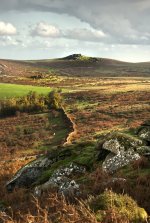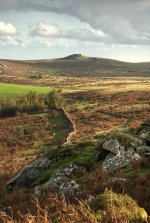and help to keep the site free for all
You are using an out of date browser. It may not display this or other websites correctly.
You should upgrade or use an alternative browser.
You should upgrade or use an alternative browser.
Beginner Another Dartmoor Photo
- Thread starter Hawthorn
- Start date
I cannot tell from my iPad.
Have look at a DOF calculator eg
Have look at a DOF calculator eg
Online Depth of Field Calculator
Depth of field and hyperfocal distance calculator
www.dofmaster.com
Not a very good one unfortunately. Nikon 28-300 3.5-5.6. I'm working on upgrading my skills rather than my gearWhat lens is it?
Wow I wouldnt of known to focus there. I was hand holding as I discovered my tripod isnt happy with the weight of my FF camera and that lens so I'm a bit wary of slower shutter speeds. Really need a different tripod at some point.I would have focussed on the rocks in the foreground with an aperture of F11. You could have come down on the shutter speed, unless there was a movement in the photo.
Garry Edwards
Moderator
- Messages
- 12,320
- Name
- Garry Edwards
- Edit My Images
- No
So, you're still trying to get maximum front to back depth of field whilst ignoring the physics . . .
1. Your focus point should have been about 1/3rd of the distance into the shot. Was it though?
2. With your full-frame camera, you could and should have shot at f/16 for maximum dof, not f/9 (and certainly not F9 because the focal length is 125mm not 9mm). You could have increased the ISO setting, to allow a fairly high shutter speed to be used, to avoid the possibility of camera shake.
I would add that although the focus point should ideally be 1/3rd into the depth of the scene, if you check with the depth of field calculator that I referred you to yesterday, you will find that at f/9 the infinity distance isn't actually infinity, it comes out at much less, and the focus point should be 69m. That would give you theoretical depth of field from 34.19m to infinity.
But, as mentioned earlier, maximum depth of field (without the risk of diffraction limitation) is achieved at f/16. which puts the focus point at 39m. Your (theoretical) depth of field would then range from 19.27m to infinity.
All credit to you for experimenting, but far better to get a basic grasp of the physics, as explained in your other post, doing the same thing time and time again whilst expecting a different result was defined by Einstein as insanity
1. Your focus point should have been about 1/3rd of the distance into the shot. Was it though?
2. With your full-frame camera, you could and should have shot at f/16 for maximum dof, not f/9 (and certainly not F9 because the focal length is 125mm not 9mm). You could have increased the ISO setting, to allow a fairly high shutter speed to be used, to avoid the possibility of camera shake.
I would add that although the focus point should ideally be 1/3rd into the depth of the scene, if you check with the depth of field calculator that I referred you to yesterday, you will find that at f/9 the infinity distance isn't actually infinity, it comes out at much less, and the focus point should be 69m. That would give you theoretical depth of field from 34.19m to infinity.
But, as mentioned earlier, maximum depth of field (without the risk of diffraction limitation) is achieved at f/16. which puts the focus point at 39m. Your (theoretical) depth of field would then range from 19.27m to infinity.
All credit to you for experimenting, but far better to get a basic grasp of the physics, as explained in your other post, doing the same thing time and time again whilst expecting a different result was defined by Einstein as insanity
Last edited:
- Messages
- 7,904
- Name
- Dave
- Edit My Images
- No
Unless you have a bad copy the lens is pretty good. Good enough for Jay Maisel at any rate - https://www.peachpit.com/articles/article.aspx?p=2319595&seqNum=2Not a very good one unfortunately. Nikon 28-300 3.5-5.6. I'm working on upgrading my skills rather than my gear
If you can't/don't use a tripod, while vibration reduction in lenses is pretty good it still requires good hand-holding technique to be effective. Moose has some 'solid' advice that might help. Youtube Link as does Joe MacNally - Another YT Link
Thanks Garry. That image was shot on the same trip as the ones in the other threads. Just trying to cement my understanding before I get back out there and make the same mistakes. Thanks for the advice.So, you're still trying to get maximum front to back depth of field whilst ignoring the physics . . .
1. Your focus point should have been about 1/3rd of the distance into the shot. Was it though?
2. With your full-frame camera, you could and should have shot at f/16 for maximum dof, not f/9 (and certainly not F9 because the focal length is 125mm not 9mm). You could have increased the ISO setting, to allow a fairly high shutter speed to be used, to avoid the possibility of camera shake.
I would add that although the focus point should ideally be 1/3rd into the depth of the scene, if you check with the depth of field calculator that I referred you to yesterday, you will find that at f/9 the infinity distance isn't actually infinity, it comes out at much less, and the focus point should be 69m. That would give you theoretical depth of field from 34.19m to infinity.
But, as mentioned earlier, maximum depth of field (without the risk of diffraction limitation) is achieved at f/16. which puts the focus point at 39m. Your (theoretical) depth of field would then range from 19.27m to infinity.
All credit to you for experimenting, but far better to get a basic grasp of the physics, as explained in your other post, doing the same thing time and time again whilst expecting a different result was defined by Einstein as insanity
Ha well I better stop blaming my gear then. Thanks for all that. Watched the videos and read the article. Will be putting it in to practice ASAP.Unless you have a bad copy the lens is pretty good. Good enough for Jay Maisel at any rate - https://www.peachpit.com/articles/article.aspx?p=2319595&seqNum=2
If you can't/don't use a tripod, while vibration reduction in lenses is pretty good it still requires good hand-holding technique to be effective. Moose has some 'solid' advice that might help. Youtube Link as does Joe MacNally - Another YT Link
- Messages
- 7,904
- Name
- Dave
- Edit My Images
- No
To my dismay I've learned that, in my case, it's rarely the gear that's the problem!Ha well I better stop blaming my gear then. Thanks for all that. Watched the videos and read the article. Will be putting it in to practice ASAP.

- Messages
- 25,322
- Name
- Phil
- Edit My Images
- No
Due to my ‘photographic experience’ I’ve got some fairly high end equipment. But the best landscape image I ever shot was fairly ‘average’ and shot on my phone.To my dismay I've learned that, in my case, it's rarely the gear that's the problem!
Decent gear hasn’t helped me shoot a decent picture of:
landscapes
Wildlife
Architecture
Aircraft
Etc etc
Last edited:
- Messages
- 25,322
- Name
- Phil
- Edit My Images
- No
I should have added; what’s stopped me shooting those images is a simple and straightforward lack of effort.Due to my ‘photographic experience’ I’ve got some fairly high end equipment. But the best landscape image I ever shot was fairly ‘average’ and shot on my phone.
Decent gear hasn’t helped me shoot a decent picture of:
landscapes
Wildlife
Architecture
Aircraft
Etc etc
Garry Edwards
Moderator
- Messages
- 12,320
- Name
- Garry Edwards
- Edit My Images
- No
I'm the same. We all have our own areas of interest, and landscape photography is one of the genres that holds zero interest for me. But, there are some outstanding landscape photographers here on TP, and those who find the subject interesting can learn a lot from them.I should have added; what’s stopped me shooting those images is a simple and straightforward lack of effort.
- Messages
- 9,782
- Name
- wayne clarke
- Edit My Images
- Yes
The "rule" is focus about a third of the way into the photograph. Personally I'd have taken two shots, one with the rocks in the foreground sharp and one focused further into the pic, maybe the trees? and combined the two in editing software.
The rule is one of those best practice ideas left over from film days and isn't really a rule in the true sense, although is does often work.
I've tweaked the local contrast a bit and sharpened it a bit in photoshop.

The rule is one of those best practice ideas left over from film days and isn't really a rule in the true sense, although is does often work.
I've tweaked the local contrast a bit and sharpened it a bit in photoshop.

Plain Nev
Vincent Furnier
- Messages
- 2,021
- Name
- Neville
- Edit My Images
- Yes
The "rule" is focus about a third of the way into the photograph. Personally I'd have taken two shots, one with the rocks in the foreground sharp and one focused further into the pic, maybe the trees? and combined the two in editing software.
The rule is one of those best practice ideas left over from film days and isn't really a rule in the true sense, although is does often work.
I've tweaked the local contrast a bit and sharpened it a bit in photoshop.
View attachment 407736
That's true. I only use the former because I don't have the ability to photo stack. And... well it works for me.
That looks much better! Thanks for doing it.The "rule" is focus about a third of the way into the photograph. Personally I'd have taken two shots, one with the rocks in the foreground sharp and one focused further into the pic, maybe the trees? and combined the two in editing software.
The rule is one of those best practice ideas left over from film days and isn't really a rule in the true sense, although is does often work.
I've tweaked the local contrast a bit and sharpened it a bit in photoshop.
View attachment 407736


